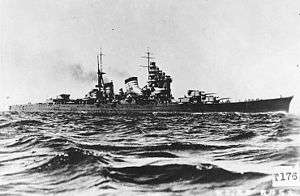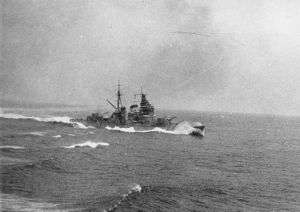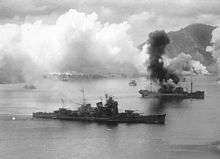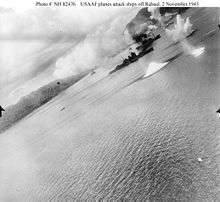Japanese cruiser Haguro
 | |
| History | |
|---|---|
| Name: | Haguro |
| Namesake: | Mount Haguro |
| Ordered: | 1924 |
| Builder: | Mitsubishi shipyard, Nagasaki |
| Laid down: | 16 March 1925 |
| Launched: | 24 March 1928 |
| Commissioned: | 25 April 1929 |
| Struck: | 20 June 1945 |
| Fate: | Sunk in the Strait of Malacca by gunfire and torpedoes from Royal Navy destroyers, 16 May 1945 |
| General characteristics | |
| Class and type: | Myōkō-class cruiser |
| Displacement: | 13,300 long tons (13,500 t) |
| Length: | 201.7 m (661 ft 9 in) |
| Beam: | 20.73 m (68 ft 0 in) |
| Draft: | 6.32 m (20 ft 9 in) |
| Installed power: | 130,000 shp (97,000 kW) |
| Propulsion: |
|
| Speed: | 36 kn (41 mph; 67 km/h) |
| Range: | 8,000 nmi (15,000 km) at 14 kn (16 mph; 26 km/h) |
| Complement: | 773 |
| Armament: |
|
| Armor: |
|
| Aircraft carried: | 2 × floatplanes |
| Aviation facilities: | 1 × catapult |
| Service record | |
| Part of: |
|
| Operations: |
|
Haguro (羽黒) was a Myōkō-class heavy cruiser of the Imperial Japanese Navy, named after Mount Haguro in Yamagata Prefecture. Commissioned in 1929, Haguro saw significant service during World War II, participating in nine naval engagements. She was sunk in 1945 during a fight with Royal Navy destroyers, one of the last major Japanese warships to be sunk during World War II.
Design
Haguro was the third of the four-member Myōkō class of heavy cruiser; the other ships were Myōkō (妙高), Nachi (那智), and Ashigara (足柄). The ships of this class displaced 13,300 tons, were 201 metres (659 ft) long, and were capable of 36 knots (67 km/h; 41 mph). They carried two aircraft and their main armament was ten 203 mm (8 in) guns in five twin turrets. At the time they were built, this was the heaviest armament of any cruiser class in the world.
Construction and career

Haguro was laid down at the Mitsubishi shipyard in Nagasaki on 16 March 1925, launched and named on 24 March 1928, and was commissioned into the Imperial Navy on 25 April 1929. Her service in World War II started in the Dutch East Indies, where she engaged the enemy off Makassar on 8 February 1942.
Haguro played a key role in the Battle of the Java Sea on 27 February 1942, and was involved in the sinking of the cruisers HMS Exeter and the Dutch flagship HNLMS De Ruyter, the destroyer HNLMS Kortenaer and of the destroyer HMS Encounter in another action off south Borneo on 1 March 1942.
On 7 May 1942, she participated in the Battle of the Coral Sea, moving on to the Solomon Islands where she took part in the Battle of the Eastern Solomons on 24 August 1942, the evacuation from Guadalcanal at the end of January 1943. Haguro took light damage in the Battle of Empress Augusta Bay on 2 November 1943. On 19 June 1944, she survived the Battle of the Philippine Sea, and from 23–25 October 1944 she took light damage in the Battle of Leyte Gulf.
Battle of Malacca Strait and fate
In May 1945, Haguro was the target of the British "Operation Dukedom" and was ambushed. The 26th Destroyer Flotilla found her with the destroyer Kamikaze just after midnight on 16 May 1945, and began the attack. During the battle, Kamikaze was lightly damaged, but Haguro was hit by gunfire and three Mark IX torpedoes from the British destroyers. She soon began to slow down and took a 30-degrees list to port.
At 02:32, Haguro began to go down stern first in the Malacca Strait, 55 mi (48 nmi; 89 km) off Penang; Kamikaze rescued 320 survivors, but 900 men, including Vice Admiral Hashimoto and Rear Admiral Sugiura, perished with her.[2] Rear Admiral Sugiura was later promoted to Vice Admiral posthumously on 16 May. Haguro was the last major Japanese warship to be sunk in battle during the war.[3]
Haguro was stricken from the navy list on 20 June 1945. The wreck was discovered in 2003, showing significant superstructure damage from her last and earlier battles.

Notes
- ↑ Lacroix, Japanese Cruisers, p. 808-811.
- ↑ Denlay, Kevin. "Summary of Expedition "Operation Dukedom" which carried Explorers Club Flag #52 while surveying the wreck of HIJMS Haguro, Malacca Strait November 8th-November 23rd 2010" (pdf). The Explorers Club.org. Retrieved 12 September 2015.
- ↑ Jackson, Ashley (2006). The British Empire and the Second World War. London: Hambledon Continuum. p. 302. ISBN 1-85285-417-0.
References
Books
- Winton, John (1979). Sink the Haguro!. Seeley, Service & Co. ISBN 0-330-28139-9.
- Cox, Robert Jon (2010). The Battle Off Samar: Taffy III at Leyte Gulf (5th Edition). Agogeebic Press, LLC. ISBN 0-9822390-4-1.
- D'Albas, Andrieu (1965). Death of a Navy: Japanese Naval Action in World War II. Devin-Adair Pub. ISBN 0-8159-5302-X.
- Dull, Paul S. (1978). A Battle History of the Imperial Japanese Navy, 1941-1945. Naval Institute Press. ISBN 0-87021-097-1.
- Lacroix, Eric; Linton Wells (1997). Japanese Cruisers of the Pacific War. Naval Institute Press. ISBN 0-87021-311-3.
External reference links
- Kosour, Ladislav (1999–2007). "Haguro". Warships of World War II. Retrieved 2007-02-22.
- Parshall, Jon; Bob Hackett; Sander Kingsepp; Allyn Nevitt. "Imperial Japanese Navy Page (Combinedfleet.com)". Retrieved 2006-06-14.
External links
| Wikimedia Commons has media related to Cruiser Haguro. |
